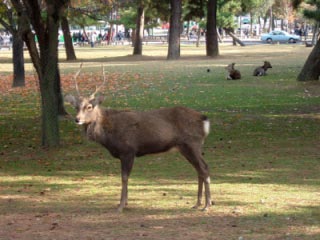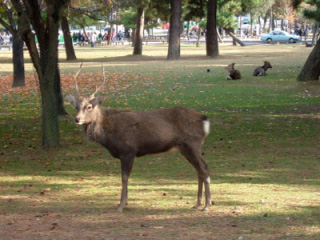Natural Selection Enables the Preservation of Information
Richard Dawkins clams that genetic information is digital information [1]. This is the same as stating that the genetic code is natural number. This claim is very important, because digital information is suitable as a target of the natural selection. The advantage of digital information is easy to find the point of the error. I will take an example to show the advantage. Two pictures are shown below.

picture1

picture2
Both two pictures are jpeg images of 320X240 pixels. Picture1 is 35,376 bytes and picture2 is 60,724 bytes. The amount of information of the photograph 1 is compressed into 58% of the amount of information of the photograph 2. However, I cannot easily recognize the difference between picture 1 and picture 2, since the human being recognizes a picture in analog. On the contrary, genetic code, which is digital information, is easy to find the point of the error.
GATCCT→GATCAT
The replication of the five letters sequence of genetic code is shown above. The fifth C has changed into A, in the replication from the left sequence to the right sequence. Thus, in digital information, the position of an error is known easily.
If the substitution of the fifth base were fatal for the living organisms, the fifth base would be preserved. This preservation depends on natural selection and dose not depends on the accuracy of the copy. Regardless of the accuracy of copy, natural selection preserves fifth C. How the precision of the copy is high, information will be lost without natural selection. For example, even if it is copied at accuracy of 99%, the original data will become below half, when it is copied 70 times. According to the statement of the second law of thermodynamics by Rudolf Clausius [2], the entropy of an isolated system not in equilibrium will tend to increase over time, approaching a maximum value at equilibrium. Thus, by the non-biological process, entropy always increases. Therefore, even if information is stored by any kind of non-biological method, it will be lost for a long time.
We shall discuss the reason why the living organisms can preserve information despite the second law of thermodynamics. The first to be noticed is that the irreversible process in an isolated system can be theoretically made reversible by the exchange of energy and matter with the outside by the human beings. For example, if a hot stone contact a lump of ice in a closed thermos bottle, the stone will be cooled and the ice will melt into water. The inside of the thermos bottle will become the same temperature anywhere. This process is irreversible in an isolated system. Although, after reaching equilibrium, if we will open the thermos bottle and will pick up the stone and will move water to another container, and then we will heat the stone by a fire and will cool water by a freezer, we will be able to get again the hot stone and the lump of ice.
As mentioned in the example, the non-biological process is theoretically reversible. Moreover, the diamond can be formed from carbon atoms. In theory, these processes are reversible. By contrast, there is no report that the dead living thing revived in the history of the biological science. If it is assumed that a unit of the life is a cell, the death of a cell is only irreversible process on the earth. Therefore, only the natural selection can preserve information for a long time, because the natural selection eliminates replication errors irreversibly by death of the life. Take histone H4 for example [3]. Histone H4 is very important nucleoprotein. The amino-acid sequence in histone H4 in pea plants differs from that in cattle by only two changes in total of 102 amino acid sites. It is assumed that plants and animals last shared common ancestor 1.2 billion years ago. The sequence has been highly preserved. This is a surprising fact. Continents have moved, and geographical features have been changed greatly for 1.2 billion years. Perhaps, there is no object leaving the original form on the surface of the earth during 1.2 billion years.
As mentioned above, the natural selection enables preservation of genetic information. Here is another example. The fidelity of copying DNA during replication is such that only about 1 mistake is made for every 109 nucleotides copied [4]. By contrast, an error frequency of about 1 in 104 is found both in RNA synthesis and in the separate process of translating mRNA sequences into protein sequences. This level of mistakes is 100,000 times greater than that in DNA replication, where a series of proofreading processes makes the process remarkably accurate. This accuracy was provided by the evolution. Therefore, properties as the natural number of the genetic code have been strengthened by the natural selection, and the natural selection depends on properties of a cell. Finally, the genetic code came to have the property of which is close to pure natural number.
References
1. R. Dawkins, The Selfish Gene (Oxford University Press, New York, 1976).
2. The second law of thermodynamics (http://en.wikipedia.org/wiki/Second_law_of_thermodynamics)
3. M. Kimura, The Neutral Theory of Molecular Evolution (Cambridge University Press, 1983)
4. B. Alberts et Al., Molecular Biology of the Cell 4th ed. (http://www.ncbi.nlm.nih.gov/books/bv.fcgi?highlight=DNA&rid=mboc4.section.754#768)
Table of Contents


